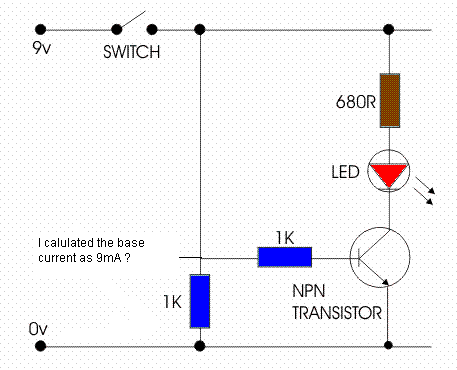expelleior
Member level 1
I grabbed this picture, of some site and thought it would be simple to work out, however I can't make sense. Does the second 1k resistor to 0V decrease the base current ? If it was meerly a pulldown i would have thought a 10K resistor would do the job.
I calculated the base current v/1k = 9mA ,
As the base current is supposed to be 1/10 of collector i know this must be wrong as there is only a LED with a 680 Resistor drawing collector current.
r u there Adioguru
Sorry i uploaded same picture twice but at least i know how to make the correct size GIF's now!
Shoudnt the resistor being connected to the te V0 be more like a 10K resistor ?
I calculated the base current of the transistor and it was 9v/1000 = 9ma
dont want motr than that flowing through the collrcter.
1.What LEDS capable of drwainmg curren t. I know ther arre A few sizeds.
2. As there asre two 1k restistlors in the circuit ; is this taking solme current fvrolm the Base of the transistor:idea:.
Thaks` Mkike
Also
Mike.

I calculated the base current v/1k = 9mA ,
As the base current is supposed to be 1/10 of collector i know this must be wrong as there is only a LED with a 680 Resistor drawing collector current.
r u there Adioguru
Sorry i uploaded same picture twice but at least i know how to make the correct size GIF's now!
Shoudnt the resistor being connected to the te V0 be more like a 10K resistor ?
I calculated the base current of the transistor and it was 9v/1000 = 9ma
dont want motr than that flowing through the collrcter.
1.What LEDS capable of drwainmg curren t. I know ther arre A few sizeds.
2. As there asre two 1k restistlors in the circuit ; is this taking solme current fvrolm the Base of the transistor:idea:.
Thaks` Mkike
Also
Mike.
